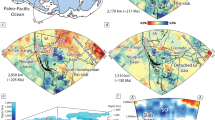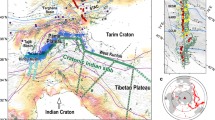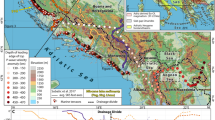Abstract
The Philippine Sea and Pacific plate slabs both subduct beneath Tokyo, and so their configuration and seismic potential have been subject to intensive study1,2,3,4,5,6,7,8. Previous work suggests that the Philippine Sea slab extends up to 100 km northwest of Tokyo and subducts to a depth of 90 km beneath the Kanto basin, where it is folded against the underlying Pacific slab. Here we evaluate seismic data in three dimensions and delineate a distinct 25-km-thick and 100-km-wide body beneath the Kanto basin that has hitherto been considered to be part of the Philippine Sea slab. We find that several of its characteristics—such as its high seismic velocity and the presence of a double seismic zone—point instead to an affinity with the Pacific slab, implying that the Philippine Sea slab penetrates to depths of only 35–40 km beneath the Kanto basin. We propose that the body is a fragment of Pacific lithosphere that formed by the collision of two intersecting seamount chains with the Japan Trench 2–3 million years ago. We suggest that such slab fragments may not be uncommon, especially where seamount subduction deforms trenches and near triple junctions.
This is a preview of subscription content, access via your institution
Access options
Subscribe to this journal
Receive 12 print issues and online access
$259.00 per year
only $21.58 per issue
Buy this article
- Purchase on Springer Link
- Instant access to full article PDF
Prices may be subject to local taxes which are calculated during checkout





Similar content being viewed by others
References
Ishida, M. Geometry and relative motion of the Philippine Sea plate and Pacific plate beneath the Kanto-Tokai district, Japan. J. Geophys. Res. 97, 489–513 (1992).
Ishida, M. The seismically quiescent boundary between the Philippine Sea plate and the Eurasian plate in central Japan. Tectonophysics 243, 241–253 (1995).
Noguchi, S. in Seismotectonics in Convergent Plate Boundary (eds Fujinawa, Y. & Yoshida, A.) 451–467 (Terra Scientific Publishing Company, 2002).
Sato, H. et al. Earthquake source fault beneath Tokyo. Science 309, 462–464 (2005).
Hori, S. Seismic activity associated with the subducting motion of the Philippine Sea plate beneath the Kanto district, Japan. Tectonophysics 417, 85–100 (2006).
Kimura, H., Kasahara, K., Igarashi, T. & Hirata, N. Repeating earthquakes activities associated with the Philippine Sea plate subduction in the Kanto district, central Japan: A new plate configuration revealed by interpolate aseismic slips. Tectonophysics 417, 101–118 (2006).
Kamiya, S. & Kobayashi, Y. Thickness variation of the descending Philippine Sea slab and its relationship to volcanism beneath the Kanto-Tokai district, central Japan. J. Geophys. Res. 112, B06302 (2007).
Wu, F., Okaya, D., Sato, H. & Huirata, N. Interaction between two subducting plates under Tokyo and its possible effect on seismic hazards. Geophys. Res. Lett. 34, L18301 (2007).
Central Disaster Management Council. Results for Estimated Damage [in Japanese] 69 (Dir. Gen. for Disaster Management, Cabinet Office, Tokyo, 2005).
Smith, A. J. et al. Intra-plate seismicity in the subducting Philippine Sea plate, southwest Japan: magnitude-depth correlations. Phys. Earth Planet. Inter. 145, 179–202 (2004).
Toda, S. & Matsumura, S. Spatial-temporal stress states estimated from seismicity rate changes in the Tokai region, central Japan. Tectonophysics 417, 53–68 (2006).
Wang, Z. & Zhao, D. Suboceanic earthquake location and seismic structure in the Kanto district, central Japan. Earth Planet. Sci. Lett. 241, 789–803 (2006).
Yamazaki, T. & Okamura, Y. Subducting seamounts and deformation of overriding forearc wedges around Japan. Tectonophysics 160, 207–229 (1989).
Ammon, C. J., Kanamori, H. & Lay, T. A great earthquake doublet and seismic stress transfer cycle in the central Kuril islands. Nature 451, 561–565 (2008).
Haston, R. B. & Fuller, M. Paleomagnetic data from the Philippine Sea plate and their tectonic significance. J. Geophys. Res. 96, 6073–6098 (1991).
Hall, R., Fuller, M., Ali, J. R. & Anderson, C. D. Active Margins and Marginal Basins of the Western Pacific 371–404 (American Geophysical Union, 1995).
Ali, J. R. & Moss, S. J. Miocene intra-arc bending at an arc–arc collision zone, central Japan: Comment. The Island Arc 8, 114–123 (1999).
Kamata, H. & Kodama, K. Volcanic history and tectonics of the Southwest Japan arc. The Island Arc 8, 393–403 (1999).
Yamamoto, Y. & Kawakami, S. Rapid tectonics of the Late Miocene Boso accretionary prism related to the Izu-Bonin arc collision. The Island Arc 14, 178–198 (2005).
Sdrolias, M., Roest, W. R. & Mueller, R. D. An expression of Philippine Sea Plate rotation; the Parece Vela and Shikoku Basins. Tectonophysics 394, 69–86 (2004).
Shelly, D., Beroza, G. C., Ide, S. & Nakamula, S. Low-frequency earthquakes in Shikoku, Japan, and their relationship to episodic tremor and slip. Nature 442, 188–191 (2006).
Obara, K. & Hirose, H. Non-volcanic deep low-frequency tremors accompanying slow slips in the southwest Japan subduction zone. Tectonophysics 417, 33–51 (2006).
Grunewald, E. & Stein, R. S. A new 1649–1884 catalog of destructive earthquakes near Tokyo and implications for the long-term seismic process. J. Geophys. Res. 111, B12306 (2006).
Nishimura, T., Sagiya, T. & Stein, R. S. Crustal block kinematics and seismic potential of the northernmost Philippine Sea plate and Izu microplate, central Japan, inferred from GPS and leveling data. J. Geophys. Res. 112, B05414 (2007).
Tatsumi, Y. Formation of volcanic front in subduction zones. Geophys. Res. Lett. 13, 717–720 (1986).
Hasegawa, A. & Nakajima, J. The State of the Planet: Frontiers and Challenges in Geophysics 81–93 (Int. Un. Geod. Geophys. and American Geophysical Union, 2004).
Kaizuka, S. Quaternary crustal movements in Kanto, Japan. J. Geography 94, 223–240 (1987).
Zhao, D., Hasegawa, A. & Horiuchi, S. Tomographic imaging of P and S wave velocity structure beneath northeastern Japan. J. Geophys. Res. 97, 9909–19928 (1992).
Hasegawa, A., Horiuchi, S. & Umino, N. Seismic structure of the northeastern Japan convergent margin: A synthesis. J. Geophys. Res. 99, 22295–22312 (1994).
Nakajima, J. & Hasegawa, A. Anomalous low-velocity zone and linear alignment of seismicity along it in the subducted Pacific slab beneath Kanto, Japan: Reactivation of subducted fracture zone? Geophys. Res. Lett. 33, L16309 (2006).
Mochizuki, K., Yamada, T., Shinohara, M., Yamanaka, Y. & Kanazawa, T. Weak interplate coupling by seamounts and repeating M∼7 earthquakes. Science 321, 1194–1197 (2008).
Acknowledgements
We are indebted to J. Nakajima and A. Hasegawa for tomographic expertise and thank W. Thatcher, J. Lin, T. Seno, Y. Okada and M. Billen for reviews and discussion. We are grateful for financial support from Swiss Re.
Author information
Authors and Affiliations
Corresponding author
Supplementary information
Supplementary Information
Supplementary Information (PDF 6480 kb)
Supplementary Information
Supplementary Movie (for high-speed connection) — the Movie can also be downloaded from http://sicarius.wr.usgs.gov/fragment/ (SWF 62190 kb)
Supplementary Information
Supplementary Movie (degraded for low-speed connection) (SWF 24031 kb)
Rights and permissions
About this article
Cite this article
Toda, S., Stein, R., Kirby, S. et al. A slab fragment wedged under Tokyo and its tectonic and seismic implications. Nature Geosci 1, 771–776 (2008). https://doi.org/10.1038/ngeo318
Received:
Accepted:
Published:
Issue Date:
DOI: https://doi.org/10.1038/ngeo318
This article is cited by
-
Seismic reflection imaging of deep crustal structures using local earthquakes in the Kanto region, Japan
Earth, Planets and Space (2023)
-
Configuration and structure of the Philippine Sea Plate off Boso, Japan: constraints on the shallow subduction kinematics, seismicity, and slow slip events
Earth, Planets and Space (2019)
-
Broadband Ground Motion Reconstruction for the Kanto Basin during the 1923 Kanto Earthquake
Pure and Applied Geophysics (2011)
-
Breaking the slab
Nature Geoscience (2008)



